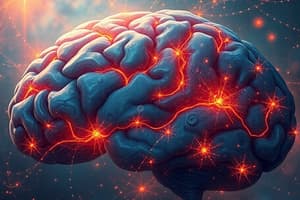Podcast
Questions and Answers
What is the primary function of the hippocampus in relation to memory?
What is the primary function of the hippocampus in relation to memory?
- Processing emotional responses
- Encoding sensory information
- Storage of long-term memory (correct)
- Maintaining motor skills
Which part of memory is responsible for temporarily holding current or recently attended information?
Which part of memory is responsible for temporarily holding current or recently attended information?
- Long-term Memory
- Procedural Memory
- Short-term Memory (correct)
- Sensory Memory
What is the maximum duration of short-term memory without rehearsal?
What is the maximum duration of short-term memory without rehearsal?
- 5 seconds
- 30 seconds
- 20 seconds (correct)
- 15 seconds
What type of amnesia involves loss of memory for information prior to brain injury?
What type of amnesia involves loss of memory for information prior to brain injury?
Which component of the multi-store memory model is primarily responsible for processing sensory stimuli?
Which component of the multi-store memory model is primarily responsible for processing sensory stimuli?
Which component of working memory is responsible for integrating its various parts with long-term memory?
Which component of working memory is responsible for integrating its various parts with long-term memory?
How does attention affect memory processing?
How does attention affect memory processing?
Which brain area is primarily involved in procedural memory and motor learning?
Which brain area is primarily involved in procedural memory and motor learning?
Flashcards are hidden until you start studying
Study Notes
Memory and the Brain
- The temporal lobe is primarily responsible for memory processing.
- The Multi-Store Memory Model by Atkinson and Shiffrin describes how information is processed and stored in the brain.
- Attention is crucial for remembering information, allowing us to focus on select stimuli.
- Sensory memory initially encodes sensory information, but has a short duration and limited capacity. It is responsible for filtering out unimportant information.
- Short-term memory (STM) temporarily holds information for immediate use, lasting approximately 20 seconds without rehearsal. Rehearsal, the process of repeating information verbally or mentally, helps retain information in STM.
- Long-term memory (LTM) is an unconscious storage system with unlimited capacity. Information is stored for long periods and requires cues for retrieval into STM.
- The Working Memory Model consists of:
- Phonological Loop: Processes and rehearses verbal information.
- Visuospatial Sketchpad: Processes and rehearses visual information.
- Central Executive: Controls attention and shifts focus.
- Episodic Buffer: Integrates information from other working memory components and interacts with long-term memory.
- The hippocampus, located in the temporal lobe, is crucial for memory consolidation.
- It is part of the limbic system, which is associated with emotions, explaining the strong link between memory and emotions.
- The amygdala, located above the hippocampus, is primarily involved in processing emotions but is also highly activated during memory recall, especially with fear-related memories.
- The sense of smell is directly connected to the hippocampus through the olfactory bulbs, strengthening the association between smell and memory.
- The cerebellum plays a significant role in procedural memory and motor learning.
Amnesia
- Retrograde amnesia: Loss of memory for events or information that occurred before the onset of a brain injury or neurological condition.
- Anterograde amnesia: Impairment in forming new memories after the onset of a brain injury or neurological condition.
Studying That Suits You
Use AI to generate personalized quizzes and flashcards to suit your learning preferences.




